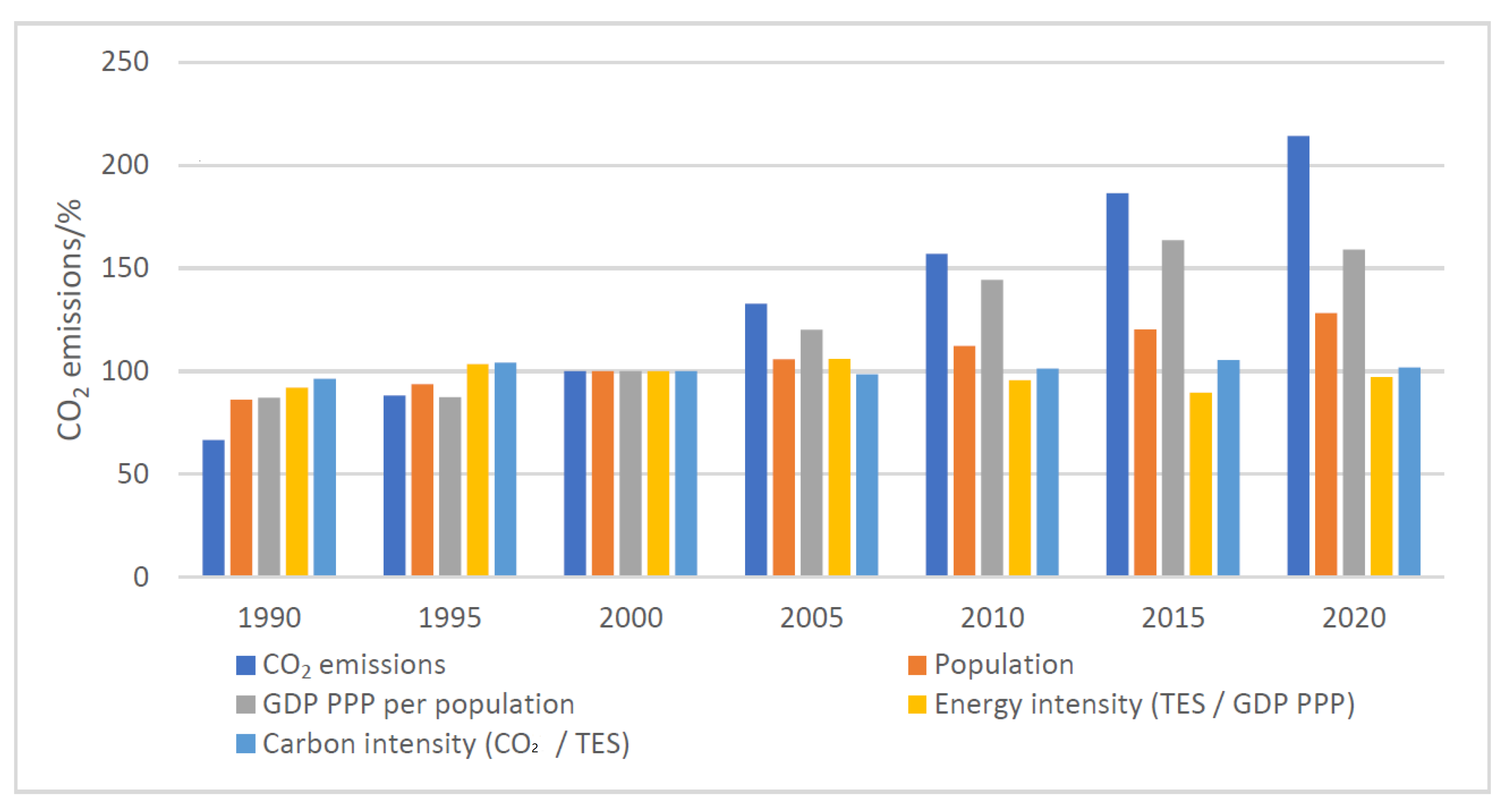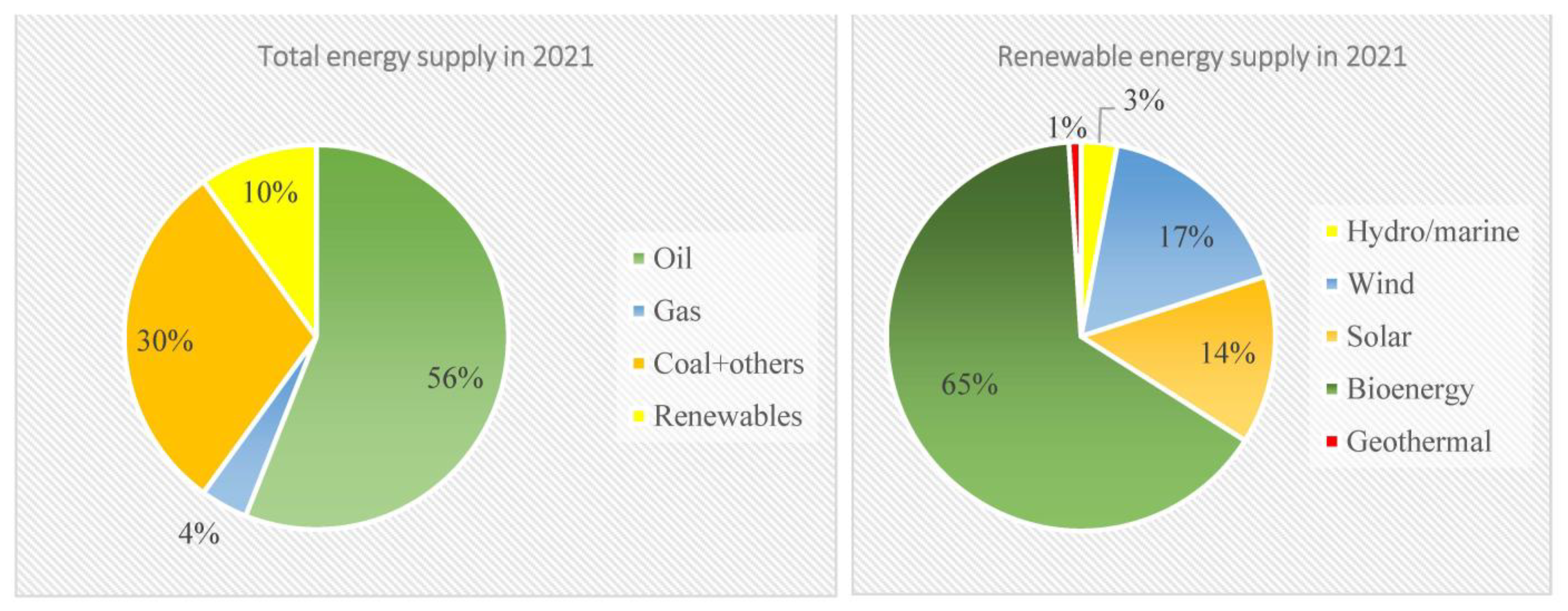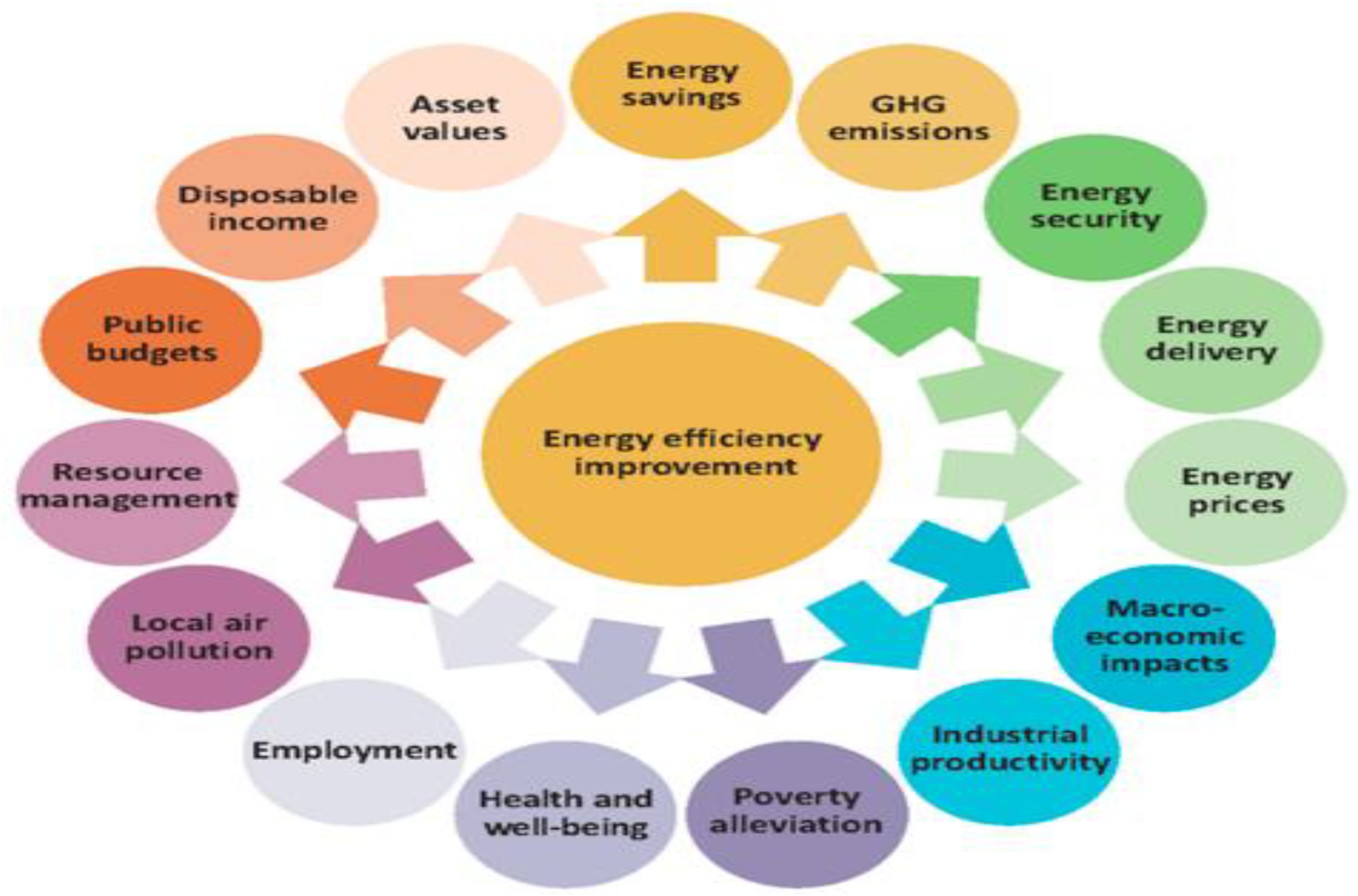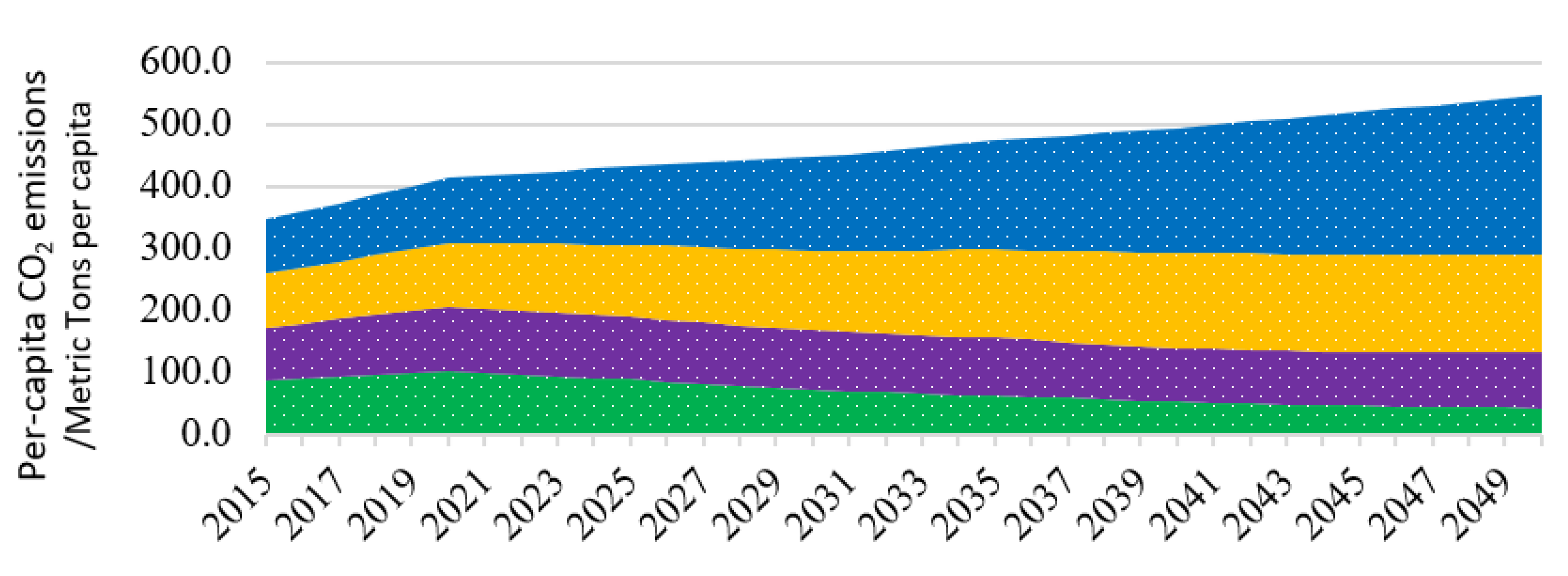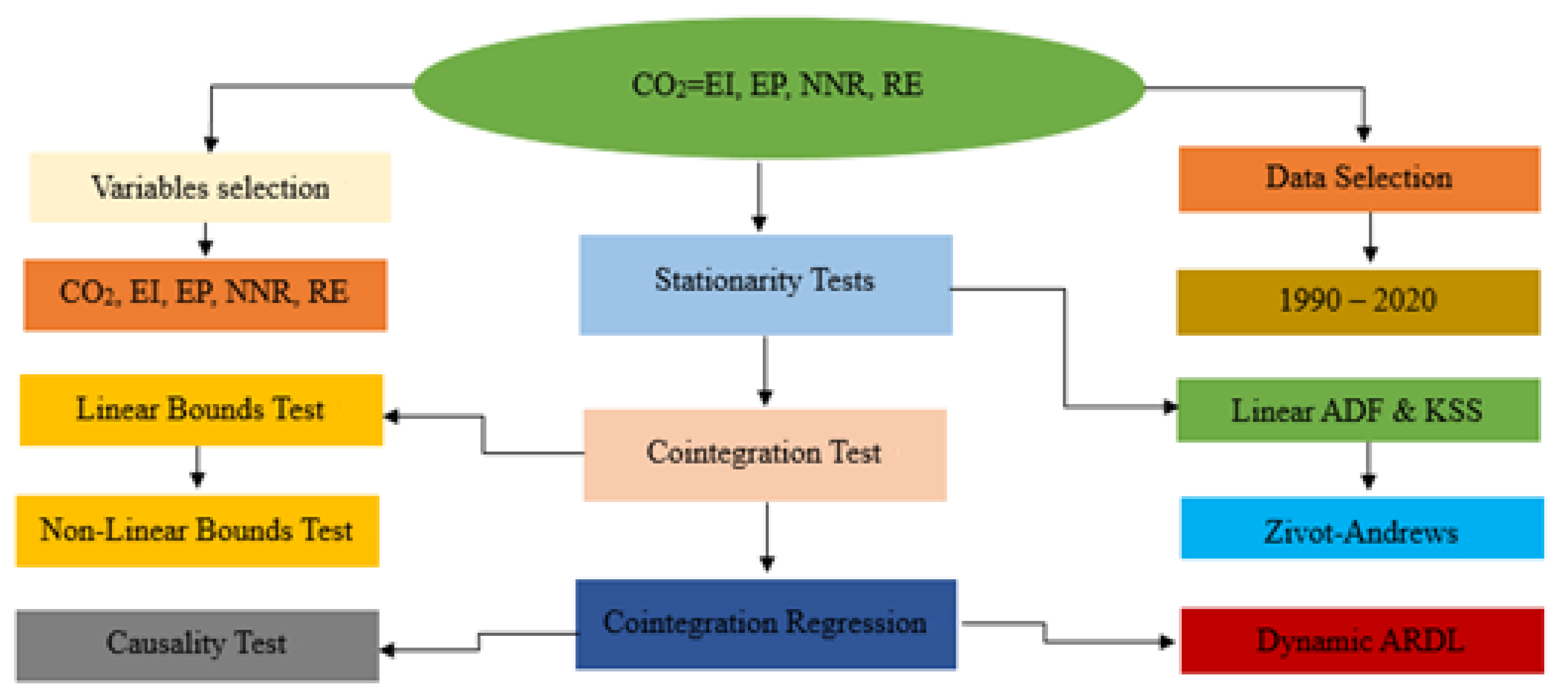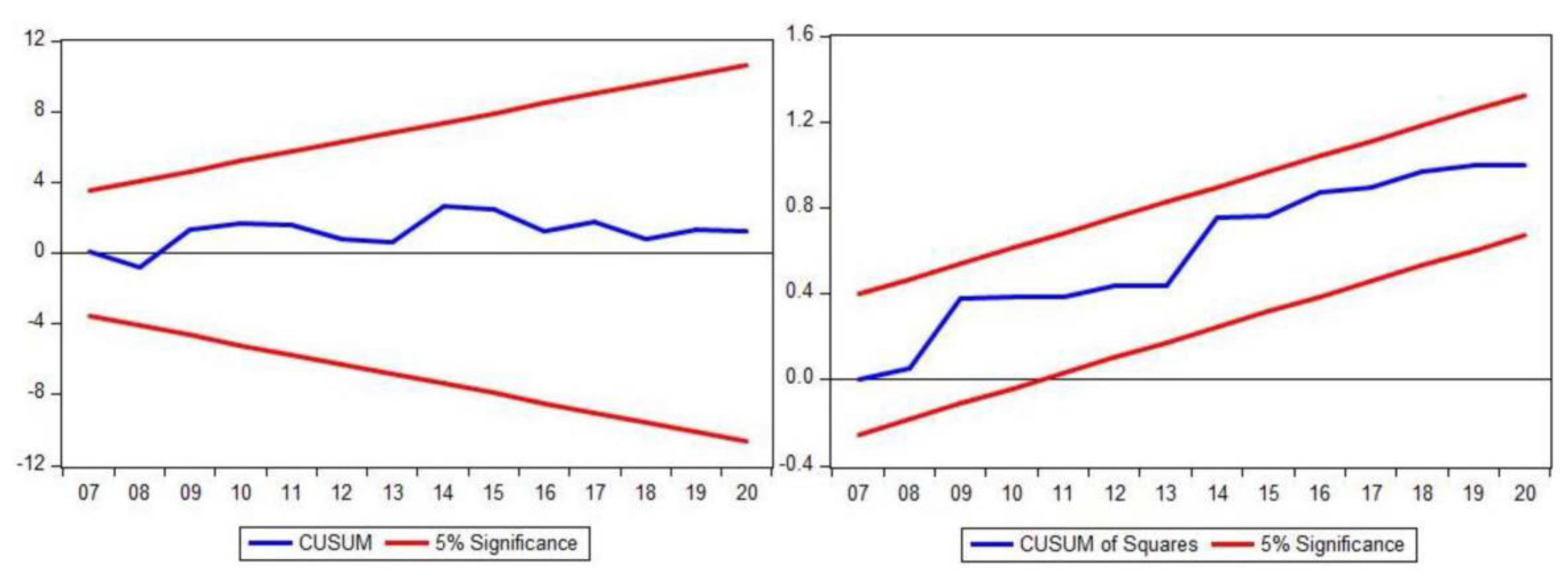1. Introduction
Energy is a necessary component for meeting the basic necessities and achieving economic development goals, but if energy production is dependent on fossil fuels, increasing energy intensity could lead to environmental damage [
1]. Energy intensity is defined as the amount of energy utilization for production purposes [
2], and it has declined worldwide at a substantial pace over the last 20 years [
3]. Although one of the main strategic goals of sustainable development is to increase energy productivity, earlier this decade there was a push to increase global energy intensity. Additionally, the improvement in EI for the global economy reached 1.7% in 2017, the second successive year with the slowest increases in energy productivity; this was less than the expected ratio of realizing average yearly increases in EI of 2.6%. The current obstacle resulted from the mishandling of energy productivity strategies in a number of significant economies and the consolidation of demand growth in countries with high energy intensities.
It has become extremely difficult to address the energy consumption and, consequently, the severity of environmental issues and energy security of fossil fuel utilization. In addition, low enhancements in EI increase carbon dioxide emissions and deteriorate the sustainable environment [
4]. EI is utilized to estimate the energy efficiency of a country [
2,
5]. Therefore, increasing energy productivity through environment-friendly technology or by changing the proportion of national output to the commodities with low EI can be an intermediate goal to mitigate EI and to enhance the environmental quality.
According to [
6], the outcomes from energy efficiency are highly noted for CO
2 mitigations. On the other hand, a negative impact on energy efficiency has a positive effect on CO
2 emissions in the long term [
7]. Albeit the possible consequences of energy efficiency, many studies have reflected its alteration when analyzing the EI level in an economy. Thus, enhancing energy efficiency is a resulting tool in achieving the energy transition. In light of this, one of the major purposes behind analyzing the status quo of environmental sustainability is countries’ dependence on fossil fuel-based energy generation. Hence, modernized attention nowadays is focused on the adaptation of energy efficiency for ensuring energy transition and reducing fossil fuel dependency. In addition, the main concerns about carbon dioxide emissions generated from fossil fuels bring forth renewable energy demands for more environmentally friendly technological solutions. Prior debates on energy efficiency have explicitly denounced the main hindrances to clean energy adaptation, including the emergence of environmental externalities, lack of technological adaptation, and energy supply issues. In order to tackle the environmental challenges, many countries have adopted various strategies related to environmental innovation via emerging energy technologies and knowledge [
8,
9]. The driving factors of CO
2 emissions in Morocco are presented in
Figure 1. The figure shows various sources such as CO
2 emissions, emissions generated by population, GDP PPP per population, energy intensity, and carbon intensity; among them, CO
2 emissions significantly contribute to environmental deterioration, followed by GDP PPP per population, which is the second largest contributor to CO
2 emissions. In addition, population and energy intensity are also substantial sources of environmental deterioration in Morocco. Therefore, the present study adopted the significance of energy intensity in Morocco. Finally, increased carbon intensity from utilizing conventional energy adversely affects environmental sustainability.
Morocco has very limited fossil fuel reserves, which indicates that the country is mainly dependent on energy imports (in 2014, the country imported 89.4% of its used energy). Since 2004, the total primary energy consumption has increased at a rate of about 5% per year, while the per capita growth rate is slightly lower, at 3.6% per year. About one-third of the total primary energy consumption is used for power generation, reaching 33,500 GWh in 2014. Morocco produces 28,000 GWh of its own and imports the rest from Spain. In 2021 Morocco’s power generation capacity was 8154 MW. Between the types of consumption, non-renewable energy and renewable energy account for 90% and 10%, respectively. Non-renewable energy consists of 30% coal, 56% fuel oil and diesel, and 4% natural gas, and renewable energy consists of 3% hydropower, 14% solar energy, 65% bioenergy, and 17% wind energy. Moreover, conventional energy generation materials such as coal and oil are the key sources of energy in Morocco, followed by natural gas and cement, as presented in
Figure 2. The historical data show the total energy supply and energy generation from renewable sources in 2021; Morocco heavily relied on conventional energy generation, which led to the deterioration of the country’s environmental sustainability.
After an in-depth study of the previous and current literature, we believe that this is a systematical study that contains a range of variables, such as CO
2 emissions, energy intensity, natural resources, energy productivity, and renewable energy consumption, taking Morocco as a case study. The major innovations that distinguish this work from the present studies are explored and contribute to the existing literature. First, this study comprehensively discusses the adoption of different factors such as energy intensity, natural resource consumption, energy productivity, and consumption of renewable energy for Morocco, to which the existing literature has paid less attention so far. Second, based on the nonlinear ARDL model developed by [
10], the present study proposes the latest key insights to explore the negative and positive shocks for CO
2 emissions in Morocco, which fills the gap in the existing research on the EI and CO
2 emissions association through energy productivity. Third, to explore the connection among study variables, a more consolidated method for critical values
p-value approximation developed by [
11] is adopted in the paper. The authors also utilize the Zivot–Andrews structural break unit root test proposed by [
12] to verify the data stationarity.
The originality of this research lies in its comprehensive analysis of the association of EI, NRR, EP, RE, and CO2 emissions. While previous research has examined these factors individually, this study will provide a holistic view of their interdependencies and their collective impact on carbon emissions. The research will contribute to the ongoing global efforts to address climate change and promote sustainable development.
The rest of paper is organized as below: The model formulation, data sources, and econometric analysis are all covered in
Section 2. The empirical results of the current study are highlighted in
Section 3 with results and discussions. The last section analyses the conclusion, policy suggestions, and further research.
1.1. Literature Review
The present study endeavors to examine the short-run and long-run effects of energy intensity (EI), natural resource rents (NRRs), energy productivity (EP), and renewable energy (RE) consumption on CO2 emissions from 1990 to 2020 and make recommendations for policy in light of Morocco’s rising energy intensity. The literature review component of the present study is divided into the following four sections.
1.1.1. The Connection between EI and CO2 Emissions
Improving energy intensity is essential for economic growth and sustainable development that may abate carbon emissions through the deployment of efficient alternatives. In order to analyze the energy intensity, some studies have highlighted the sectorial and regional changes in particular economies. The authors of [
13] analyzed energy intensity in 40 major economies by employing the Logarithm Mean Decomposition (LMD) model, and the findings revealed that changes in the industry mix from 1995 to 2007 caused a decline in energy intensity. However, technological changes contributed to improving energy intensity at a global level. The authors of [
14] investigated the main drivers of energy intensity reduction for transition countries (Central and Eastern Europe) over the period 1992 to 1998. The results of the study reflected the effect of economic sectors on EI changes; the EI of the industrial sector declined while the structural change promoted the increase in EI. In addition, [
15] advocated the nexus between EI and CO
2 emissions in the USA during 1985–2017 by using the ARDL model; the findings revealed that higher EI contributes to pollution. The authors of [
16] examined the role of EI on carbon intensity in 25 emerging economies from 1990 to 2018. The results revealed that EI affects carbon intensity positively in the long run. Moreover, [
17] applied the dynamic threshold regression model to explore the impact of RE on EI. The results indicated that a 10% increase in RE will lead to a decrease of 2.2% in EI, which may be significant to the carbon intensity level. Furthermore, [
18] exhibited the tendency of EI and CO
2 emissions in Ecuador from 2000 to 2030 differently. Based on the system dynamics model, the improvement in EI by 2030 along with the decrease in CO
2 emissions to a certain degree will occur because of the trends in the use of renewable energies and energy efficiency.
1.1.2. The Association between EP and CO2 Emissions
The existing literature on energy productivity and CO
2 emissions has noted that the amelioration of energy efficiency and decoupling of energy use from economic growth may abate the carbon emissions [
18,
19,
20,
21]. The study of [
22] indicated the impact of EP on CO
2 emissions in China from 1991 to 2017. The results stressed that the improvement in EP exerts a negative effect on CO
2 emissions. Additionally, another study proposed by [
23] explored the linkage between EP and CO
2 for G7 countries during 1990–2018. Using different tests, including the CS-ARDL, the study suggested that EP is a useful tool to restrict CO
2 emissions in G7 countries. Moreover, reducing energy usage and improving energy efficiency are the main outlines of EP playing a part in decreasing energy costs and enhancing productivity. The previous literature stressed that EP contributed to energy efficiency and energy costs; thus, the three standards can reflect one another when analyzing their impact on CO
2 emissions [
24]. According to [
25], energy productivity is the indicator of a nation’s energy efficiency rather than its energy intensity. In the same way, [
26] revealed that technological progress can be subject to improving energy efficiency. In [
27], the empirical results suggested that EP is very important to realizing the goal of the carbon neutrality of N11 countries. The authors of [
28] estimated the linkage between EP and RE consumption for OECD economies from 1990 to 2017. The findings suggested that EP assists the increase in RE consumption, which has a direct relationship to the reduction in CO
2 emissions. Similarly, [
29] employed the CS-ARDL model to emphasize that EP significantly reduces CO
2 emissions in G7 economies. The study also suggested that eco-innovation, along with energy productivity, contributes to CO
2 emission reductions.
1.1.3. The Impact of Natural Resources on CO2 Emissions
After studying different literature works on the linkage between NRR and CO
2 emissions, it turned out that the majority of the studies identified a positive connection between natural resources, carbon emissions, and environmental degradation. The authors of [
30] investigated the general effect of natural resources in the G7 economies by the DOLS approach. The findings indicated that NRRs have a significant positive effect on CO
2 emissions. In [
15], the authors explored the impact of natural resources on environmental pollution for BRICS countries from 1990 to 2015 by utilizing the EKC hypothesis; the findings revealed that the abundance of natural resources is consequential for pollution reduction in Russia. Consequently, correcting the effects of globalization and urbanization by the increase in natural resource depletion has been disclosed by many studies [
31,
32], whereas [
33] revealed that natural resource abundance helps control CO
2 emissions. The study analyzed the driving factors of CO
2 emissions in EU5 countries by employing the EKC hypothesis, while the negative impact of natural resource abundance on CO
2 emission is due to the decrease in oil imports, by which countries can upgrade their mitigation efforts.
1.1.4. The Connection between RE and CO2 Emissions
The construction of substitutive methods to reduce carbon dioxide emissions and achieve global transformation is defined as the use of renewable energy (i.e., solar, hydro, wind), which can replace traditional non-renewable energy production. Countries with highly developed RE have advanced technologies and management systems [
16]. Consequently, energy sources with low emissions bring opportunities for the economic development of emerging economic opportunities, promote energy technology innovations, and facilitate the development of energy distribution [
34]. The implementation of clean energy has been qualitatively assessed in recent studies, and RE was found to have a negative effect on CO
2 emissions in China [
35]. In contrast, many researchers have analyzed the non-renewable energy nexus with CO
2 emissions and proved bidirectional causalities running from CO
2 emissions and non-renewable energies to renewable energies. Thus, the noticeable circumstances of the two driving forces lead to diverging directions in terms of their impact on the climate, seeing that both require a set of measures to address the global requirements regarding renewable energy initiation and reduce the demand for conventional energy sources. The authors of [
36] investigated the situation of RE installation in China during 2010–2020 by employing the C-GEM model. The study revealed that more RE installation has created more favorable conditions for renewable energy electricity, and it has contributed to a reduction in CO
2 emissions intensity by 2%. The authors of [
37] advocated that RE has a negative effect on CO
2 emissions in the short term. Additionally, [
38] examined the impact of RE on energy security risk for 23 OECD countries by employing the Augmented Mean Group (AMG) model, and the total number of renewable energies reduced the energy security risk. However, the results may not be valid for all countries in the organization because of the lack of policy implementation for energy security risks.
1.2. Theoretical Framework
Six years after the world’s leaders reached the Paris Agreement, the levels of carbon emissions are still increasing unprecedentedly, and deadlines for air temperature reduction for the 1.5 °C and 2 °C environmental and climate objectives have grown more stringent [
39]. Increasing growth in GDP is substantially linked with raising the level of environmental degradation challenges, for instance, with the growing demand for material and energy consumption [
40]. Alternatively, degradation pathways have been explored by the expanding de-growth literature [
41]. The promotion of renewable energy development increased the subsequent prospects of climate change regeneration and replaced the habitual depletion of natural resources (i.e., gas, coal, oil, stone, metal, etc.). In addition, renewable energies have been essentially upgraded to increase energy efficiency and to reduce EI across all sectors, confronting the uninterrupted increase in energy demand globally [
42,
43]. The benefits of energy efficiency in reducing CO
2 emissions have been remarkably tied up with a prescribed utilization of renewable energies. Various studies have disclosed the significant influence of enhancing RE utilization on upgrading energy efficiency [
44,
45].
Proposition 1. Renewable energy sources and energy productivity are sources of lowering CO2 emissions in Morocco.
Morocco, on the one hand, is undergoing all the major transformations in the energy sector. The country has implemented numerous energy strategies that may alter the energy transition. The North African country adhered to the 2015 Paris Agreement with significant solar and wind capacities. The advantageous geographical location of Morocco was preordained for accelerating the energy sector development. The importance of geographical location was proposed by the most recent study. Furthermore, RE development and energy efficiency procurement in Morocco can pave the way to a sustainable economic development opportunity [
46]. The synergy between renewable energies and energy efficiency has been viewed as a way to decarbonization, embodied in higher shares in renewable energy use, energy intensity reduction, and energy cost reduction [
47].
Figure 3 visualizes Morocco’s per capita carbon emissions as less than half of the global average during 1990–2020. It can be seen that Tunisia, Sudan, and Libya are among the top pollution emitters in the MENA region.
However, EP contributes to energy efficiency [
24]. Both energy productivity and energy efficiency are identical in this study. As seen in
Figure 4, the adaptation of higher energy efficiency has several advantages, such as energy saving, energy security, energy delivery, energy prices, low air pollution, health and well-being, poverty alleviation, public budget, and disposable income, etc. In contrast, energy intensity reduction has been viewed as a fundamental measure to achieve sustainable development goals. The authors of [
2,
48] found that despite the efforts toward energy intensity lowering among the transition countries, the progress on energy efficiency is still uneven. Prospects for energy transition may be accomplished with energy efficiency, affordability, reliability, and energy independence [
49]. In this regard, the doubtful aspect is the environs of the transition. Low- and middle-income countries and countries that completely depend on fossil fuel generation are the core stakeholders of the debated energy transition. Although developing countries hold significant renewable energy potentials, they are more likely to adopt energy transition in manageable schemes [
50].
Proposition 2. Higher energy intensity adversely contributes to CO2 emissions.
The study of [
48] found an adverse connection between EI and CO
2 emissions by employing annual time-series data from 1985–2017 in the United States. Energy consumption is an inevitable force to fulfill fundamental needs and carry out economic development objectives [
1]. EI is defined as the total volume of energy utilization for production [
2]. Ref. [
3] found that energy intensity has globally declined at a substantial pace over the last 20 years. Hence, the present study proposes the importance of adaptation strategy energy efficiency to overcome higher energy intensity usage. Enhancement of world energy intensity consolidated earlier in the current decade. In 2017, the energy intensity improvement rate accounted for 1.7% of the world economy, which was considered to be the slowest time period of enhancements in energy efficiency. In 2018, it was reported that energy efficiency would enhance to 1.2%.
Figure 5 illustrates the historical trend in energy intensity in Morocco between 1990 and 2020. Based on the data, Morocco’s energy intensity has substantially increased from 1965 to 1980. However, a downward trend reflected a decrease in energy intensity from 1981 to 1992, indicating that the country adopted the lower energy intensity policy. In addition, this downward shift showed a continuous decline till 2020.
Proposition 3. Do Morocco’s policies and actions under the Paris Agreement mitigate CO2 emissions?
In 2009, Morocco launched its national energy strategy and its Paris Agreement NDC target for increasing renewable energies in the electricity mix. The country’s energy sector is heavily dependent on imported hydrocarbons, which made the government instantaneously seek an increase in affordable energy consumption. According to Morocco’s state hydrocarbons agency, the country’s sustainable alternatives are relatively sufficient despite the current political tension with the neighboring country and the continual soaring of fuel prices due to the backdrop of the war in Ukraine [
51]. The plans pushing the increase in renewable energy share have to be resilient in their short- and long-term targets. Additionally, Moroccan power generation from wind, solar, and hydropower energy projects are the most ambitious renewable energy transitions among the African countries as well as in the MENA region, but it is never enough to explain the gaps surrounding energy efficiency in the country. However, Morocco is considered an international example of efficient public policy on climate change [
52]. Morocco has acknowledged the importance of energy transition following the current deterioration of environmental quality. The country has also endorsed the United Nations Framework Convention on Climate Change (UNFCCC), the Kyoto Protocol, and the Paris Agreement in 2015 [
53]. Morocco was one of the host countries when discussing the UNFCCC’s main mechanisms for climate change mitigations in Marrakech. The present initiatives indicate that the nation is certainly disposed toward energy transition. However, the increase in CO
2 emissions in Morocco has been on a steady rise from 2002 to 2020 because of its dependence on imported energy [
54].
Figure 6 shows Morocco’s visions and actions for 1.5 °C under the Paris Agreement. Based on the figure, the green color represents that the 1.5 °C Paris Agreement is compatible, the indigo color represents that Morocco’s efforts toward decarbonization are almost sufficient, the yellow color illustrates the ratio of insufficiency of climate change mitigation policy; finally, the blue color defines the ratio of highly insufficient strategy toward climate change mitigation.
Proposition 4. Natural resource rents have a significant impact on carbon emissions.
Natural resources such as oil, gas, and coal are important sources of energy for human consumption, but their extraction and use also contribute significantly to carbon emissions. Natural resource rents are the economic rents generated from the extraction of these resources, which can have both positive and negative impacts on the economy and the environment. On the one hand, natural resource rents can provide a significant source of revenue for governments and contribute to economic growth and development. However, the dependence on natural resource rents can also lead to environmental degradation and contribute to climate change through carbon emissions.
Several studies have shown that countries with high NRRs tend to have higher levels of carbon emissions compared to countries with low NRRs. This is because natural resource-dependent countries often prioritize the extraction and export of these resources over investments in renewable energy and sustainable development. Furthermore, the economic incentives created by NRRs can lead to the neglect of environmental regulations and standards, leading to increased carbon emissions from the production and use of natural resources. The extraction of natural resources can also lead to land degradation, deforestation, and loss of biodiversity, further contributing to climate change.
3. Results and Discussion
Table 4 contains the results of the unit root test. The unit root test was used to determine if the time series was stationary or not. The data will decrease or increase throughout the course of a fixed observation if their time series lacks a unit root function, which indicates that the constant’s time-series values are not influenced with time. On the flip side, the probability function of non-stationary time series has state-dependent characters when using the stochastic technique. In the long run, the impact of exogenous shocks on the research variables will not return to the equilibrium central position or random walk conditions over time. The quality and dependability of the data must be confirmed, for example, because the econometric approach directly or indirectly uses non-stationarity time series to induce prediction pseudo-regression. Additionally, the unit root method, which is the foundation of many important statistical theories and techniques, is designed to investigate the research variables stationery.
Table 5 displays the outcomes of the Zivot–Andrews structural unit root test with a single break year. The Zivot–Andrews structural unit root test was employed in the current study to investigate the stationarity of all the variables at both the level and the first difference. By incorporating additional elements like intercept, trend and interest, single trend at the level, and initial difference, the variables were confirmed. At the intercept level, the year of the CO
2 emissions structural break was 2002, while the years of EI, EP, NRR and RE were 2006, 2012, 2008, and 2009, respectively.
Table 6 shows that RE, NRR, EP, EI, and CO
2 emissions were stationary at the first difference, indicating that the total series had the same integration order of significance (1). Morocco has enacted a number of energy policies over the past ten years, including those promoting energy security, RE adoption, and energy efficiency during the reporting period. For example, the MRV2 advisory service was founded in 2009 in response to the Ministry of Energy to support and evaluate the environmental and socioeconomic impacts of the National Energy Strategy. Furthermore, the structure break unit root the data series exhibited nonlinearity. As a result, estimations were conducted to select the ideal lag order for additional estimations after looking at structural breaks and assessing the integration order.
In addition, the evaluated value of F-statistics indicated the existence of five co-integration vectors. Therefore, the present study rejected the assumed hypothesis of the “non-existence of long co-integration among the selected variables”. Hence, this paper judged the existence of a long-term nexus among CO
2 emissions, EI, EP, NRR, and RE. Moreover, this study implemented the Johansen co-integration estimation to confirm the evaluated outcomes of the ARDL bounds method. The outcomes of the model are contained in
Table 6, and we found that the long association among variables was verified.
Table 7 displays the outcomes of the nonlinear co-integration test. For both I(0) and I(1), the test’s F-statistics were bigger than the critical values at a 1% level of significance, indicating a long standing nexus among the model’s variables. Thus, the ARDL model’s short- and long-term parameters were determined.
The outputs of ARDL long and short term are presented in
Table 8. The present paper adopted the ARDL method to explore the long- and short-term association among CO
2 emissions, EI, EP, NRR, and RE consumption in the case of Morocco. As stated in
Table 8, EI was positively associated with CO
2 emissions over the long term, indicating that a 1% growth in EI will raise carbon dioxide emissions by 0.003%. Similar findings exhibited by the study of [
48] indicated that higher EI led to environmental pollution in the US and in Spain [
62]. Moreover, EP is considered to be a significant determinant for abating carbon dioxide emissions in Morocco. Based on the findings, a 1% increase in EP will decrease CO
2 emissions by 0.30% over the long term. Our findings were supported by the study of [
27,
29]. Over the past several years, Morocco has successfully started several projects that aim at energy transformation according to the national energy strategy. The country has recently increased electricity generation from renewable sources, and the objectives specified enhanced EP as a fundamental goal.
NRR had a negative influence on carbon dioxide emissions. From the findings, a 1% increase in NRR will result in a long-term increase in CO
2 emissions of 0.026%. The total amount of NRR in Morocco constituted 1.63% of the country’s GDP in 2017. Our results concurred with the research [
63,
64]. In addition, it is widely acknowledged that extensive exploitation of natural resources will consequently raise the level of environmental pollution. A significantly negative linkage was seen between RE utilization and carbon dioxide emission. It showed that a 1% increase in RE utilization will mitigate CO
2 emissions by 0.483% over the long run. Numerous previous studies suggested that RE is a key source of abating CO
2 emissions. Finally, the value of the constant was reported as −3.625, indicating that the model fit best.
The short-run dynamics estimated outputs are illustrated in
Table 8. Based on the short-term association, lagged EI was positively associated with CO
2 emissions, indicating that a 1% rise in EI will enhance carbon dioxide emissions by 0.32% in the country. The findings further revealed a significantly negative nexus between CO
2 emissions and EP, which means that a 1% increase in the coefficient of EP will mitigate CO
2 emissions by −0.55%. In the short term, there was a significantly positive connection between NRR and CO
2 emissions. The short-run coefficient value indicated that the CO
2 emissions will surge by 0.25% when a 1% rise in natural resource consumption occurs. The long-term coefficient value indicated that the CO
2 emissions will surge by 0.11% when a 1% increase in natural resource consumption occurs. Similar outcomes were proposed by [
15]. Moreover, the empirical results further revealed that the consumption of RE (i.e., solar, wind, hydropower) will substantially reduce environmental pollution. In this study, we found a significantly negative correlation between RE and CO
2 emissions in Morocco. The results suggested that with a 1% increase in RE consumption, the level of CO
2 emissions will decline by −0.85% in the short term. The results were consistent with the study of [
65]. In the long run, there is a significantly positive connection between RE and CO
2 emissions.
To verify the ARDL estimation accuracy and consistency, the present study utilized numerous diagnostic techniques. The evaluated outcomes of the diagnostic techniques found that there was no existence of serial correlation, misspecification, heteroscedasticity, and normality. The outputs of diagnostic tests are presented in
Table 9.
In
Table 10, it can be seen that the probability values of serial correlation, heteroscedasticity, Harvey, ARCH, Glejsera, and RESET tests were statistically insignificant. In addition, the stability of the ARDL method was checked by the obtained outputs of CUSUM, and CUSUM of squares for each response variable such as CO
2 emissions, EI, EP, NRR, RE, as seen in
Figure 8.
Table 10 contains the outcomes of the ARDL bounds model. The main purpose of adopting the ARDL bounds model was its capacity to accurately predict the magnitude and probability signs of the variation flows of the determinants associated with the long- and short-term connection. By comparison, the traditional ARDL technique pays particular attention to the long- and short-run nexus of the parameters. The evaluated values of the F-statistics (for instance, 3.09, 3.49, 3.87, and 4.37) were shown to be higher than the values of the upper bound at
p < 0.001 significance levels when CO
2 emissions, EI, EP, NRR, and RE were adopted as response variables in the regression, respectively.
Table 11 displays the outcomes of both short- and long-term Granger causality tests. The findings indicated that there was a one-way causal connection between CO
2 emissions and EI, meaning that higher EI will increase CO
2 emissions while lower EI will reduce CO
2 emissions in Morocco over the long and short terms. Our results were supported by the study [
48]. Likewise, a one-way causal linkage was revealed between EP and CO
2 emissions, which means that EP such as the effective use of energy and adequate facilities for energy storage will mitigate CO
2 emissions in the selected region. In addition, the study of [
65] proposed similar findings for 16 OECD economies from 1990 to 2020.
The results of the robustness check are shown in
Table 12. We used fully-modified OLS, dynamic OLS, and canonical cointegrating regression (CCR) regression estimations. The results from the above methods confirmed that EI had a significantly positive association with CO
2 emissions, and EP had a significantly negative connection with CO
2 emissions, which indicated that energy efficiency can play an important part in reducing CO
2 emissions in Morocco. The linkage between NRR and CO
2 emission was significantly positive, indicating that the massive use of natural resources will improve CO
2 emissions. Lastly, RE had a negative connection with CO
2 emissions, indicating that the adoption of RE will therefore reduce environmental pollution. Additionally, these outputs were persistent and robust with the results obtained by the ARDL model.
4. Conclusions
This study discussed the influences of EI, EP, NRR, RE, and CO2 emissions in Morocco from 1990 to 2020 by adding EP and RE consumption in the nonlinear ARDL model to investigate their impacts on CO2 emissions. Our study found that EP plays a substantial role in mitigating environmental pollution in both the short and long term. In addition, we employed traditional ADF and PP unit root tests to examine the stationarity of selected variables. Furthermore, we used the ARDL bounds method to investigate the long-term co-integration linkage among the variables. Additionally, the authors employed the FMOLS, DOLS, and CCR testing approaches to validate the long-run ARDL outcomes.
The outputs of the present study indicated the existence of the connection among the selected variables in the long term. In addition, the nonlinear ARDL method revealed that EP enhanced environmental quality by mitigating CO2 emissions in Morocco. Conversely, EI showed a significantly negative association with CO2 emission, indicating that higher EI will increase CO2 emissions in both the long and short term. Our study showed that the exploitation and extensive use of natural resources will affect climate mitigation policy in Morocco. We found that natural resource consumption in Morocco will result in an increase in CO2 emissions in the long term. RE, i.e., solar, hydropower, wind, will substantially decrease carbon emissions in both the long term and short term. The results of FMOLS, DOLS, and CCR estimations also validated the long-run outcomes of the NARDL estimation. These findings suggested that EP not only enhances energy storage but also assists in mitigating environmental pollution and sustaining environmental sustainability.
Several policy implications were suggested by our empirical findings for Morocco to decrease CO2 emissions without compromising economic growth and to further boost energy productivity and renewable energy. Low energy intensity with technology innovation and adoption refers to the amount of energy required to produce a specific degree of output or activity.
First of all, Morocco should consider production-based and consumption-based carbon emissions commodities in further advancing the reduction of carbon emission. It is proposed to incorporate trade considerations into the top-level design, compilation, and enforcement of the CO2 peaking action plan.
Second, although EP helps to abate CO2 emissions in Morocco, it does not mean that the lower the EP, the better the environmental protection effect will be. Thus, it is of great significance to put forward a sound environmental footprint policy. Each country should carefully consider balancing carbon dioxide emissions reduction and promoting environmental footprint growth. Thus, it is significant to devise a sound EP policy, and each country should carefully consider balancing CO2 reduction and promoting EP growth. Morocco should make a commitment to energy efficiency in its adopted National Priority Action Plan for 2030. Third, policy tools to curb high EI need to be employed so as to decrease carbon emissions and enhance air quality in Morocco. For example, the European Union has continuously changed its energy policies focusing on energy conservation and RE consumption over 30 years. A series of laws and regulations have been promulgated, including the EU Green Paper on Energy Policy, EU Future Energy: Renewable Energy Paper, and the Development Directive of Renewable Energy. Thus, the consumption of RE in the EU has risen from 6% in 1998 to 19.7% in 2019, whereas the CO2 emissions have declined by 22% in the corresponding time. The requirement for non-renewable energy is still growing in most of the Belt and Road countries with the advancement of urbanization. In order to improve energy efficiency, some feasible measures may be taken, including advancing the production technologies, optimizing the energy consumption structure, and extensively employing clean energy. The current study has three limitations, which will encourage researchers to expand the relative research in the future. First of all, the estimation had to be limited from 1990 to 2020 because of data unavailability. Similarly, the authors could not find more control variables and instrumental variables because of data unavailability. Furthermore, the current study can also be expanded by assessing the unsymmetric effects of negative and positive impact shocks to EP and RE utilization on CO2 emissions in Morocco. Additionally, the causal associations among the variables can also be checked. For the purpose of designing a more comprehensive and inclusive policy, the environmental impacts of a wide range of renewable energy and energy efficiency measures can be further surveyed in the case of Morocco.
